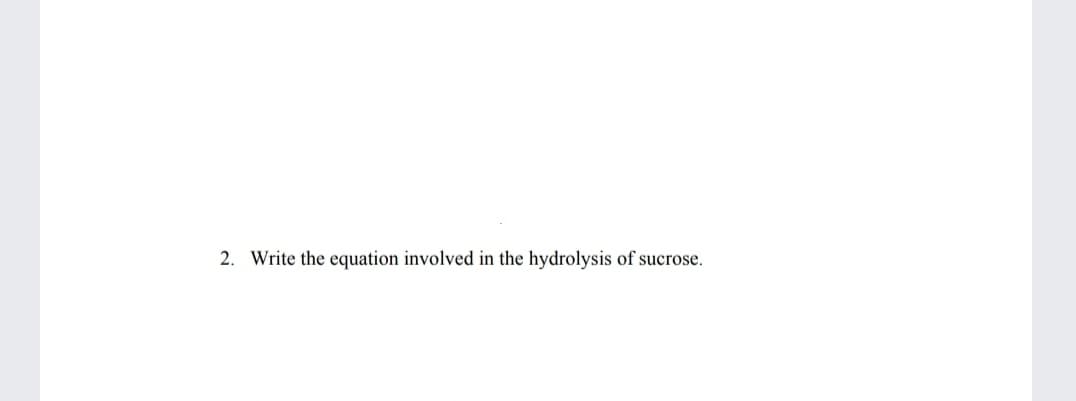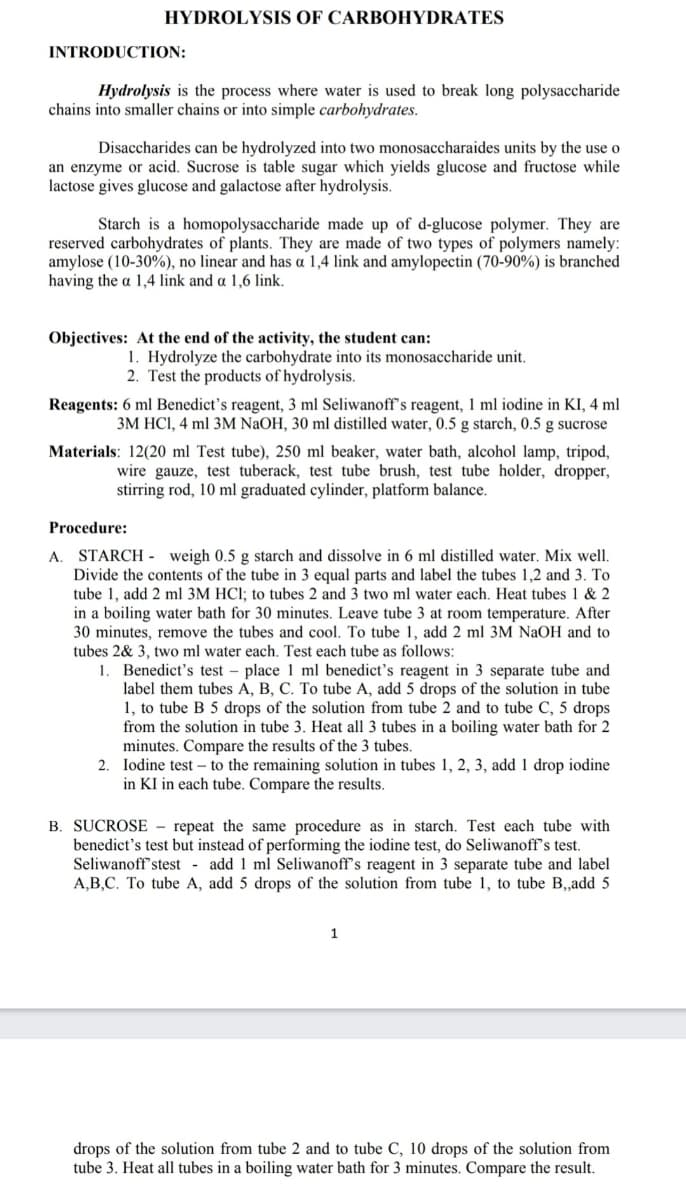2. Write the equation involved in the hydrolysis of sucrose.
Concepts of Biology
1st Edition
ISBN:9781938168116
Author:Samantha Fowler, Rebecca Roush, James Wise
Publisher:Samantha Fowler, Rebecca Roush, James Wise
Chapter2: Chemistry Of Life
Section: Chapter Questions
Problem 8RQ: An example of a monosaccharide is ________. a. fructose b. glucose c. galactose d. all of the above
Related questions
Question

Transcribed Image Text:2. Write the equation involved in the hydrolysis of sucrose.

Transcribed Image Text:HYDROLYSIS OF CARBOHYDRATES
INTRODUCTION:
Hydrolysis is the process where water is used to break long polysaccharide
chains into smaller chains or into simple carbohydrates.
Disaccharides can be hydrolyzed into two monosaccharaides units by the use o
an enzyme or acid. Sucrose is table sugar which yields glucose and fructose while
lactose gives glucose and galactose after hydrolysis.
Starch is a homopolysaccharide made up of d-glucose polymer. They are
reserved carbohydrates of plants. They are made of two types of polymers namely:
amylose (10-30%), no linear and has a 1,4 link and amylopectin (70-90%) is branched
having the a 1,4 link and a 1,6 link.
Objectives: At the end of the activity, the student can:
1. Hydrolyze the carbohydrate into its monosaccharide unit.
2. Test the products of hydrolysis.
Reagents: 6 ml Benedict's reagent, 3 ml Seliwanoff's reagent, 1 ml iodine in KI, 4 ml
3M HCI, 4 ml 3M NaOH, 30 ml distilled water, 0.5 g starch, 0.5 g sucrose
Materials: 12(20 ml Test tube), 250 ml beaker, water bath, alcohol lamp, tripod,
wire gauze, test tuberack, test tube brush, test tube holder, dropper,
stirring rod, 10 ml graduated cylinder, platform balance.
Procedure:
STARCH - weigh 0.5 g starch and dissolve in 6 ml distilled water. Mix well.
Divide the contents of the tube in 3 equal parts and label the tubes 1,2 and 3. To
tube 1, add 2 ml 3M HCl; to tubes 2 and 3 two ml water each. Heat tubes 1 & 2
in a boiling water bath for 30 minutes. Leave tube 3 at room temperature. After
30 minutes, remove the tubes and cool. To tube 1, add 2 ml 3M NaOH and to
tubes 2& 3, two ml water each. Test each tube as follows:
A.
Benedict's test – place 1 ml benedict's reagent in 3 separate tube and
label them tubes A, B, C. To tube A, add 5 drops of the solution in tube
1, to tube B 5 drops of the solution from tube 2 and to tube C, 5 drops
from the solution in tube 3. Heat all 3 tubes in a boiling water bath for 2
minutes. Compare the results of the 3 tubes.
2. Iodine test – to the remaining solution in tubes 1, 2, 3, add 1 drop iodine
in KI in each tube. Compare the results.
B. SUCROSE - repeat the same procedure as in starch. Test each tube with
benedict's test but instead of performing the iodine test, do Seliwanoff's test.
Seliwanoff'stest - add 1 ml Seliwanoff's reagent in 3 separate tube and label
A,B,C. To tube A, add 5 drops of the solution from tube 1, to tube B,,add 5
1
drops of the solution from tube 2 and to tube C, 10 drops of the solution from
tube 3. Heat all tubes in a boiling water bath for 3 minutes. Compare the result.
Expert Solution
This question has been solved!
Explore an expertly crafted, step-by-step solution for a thorough understanding of key concepts.
Step by step
Solved in 2 steps

Recommended textbooks for you

Concepts of Biology
Biology
ISBN:
9781938168116
Author:
Samantha Fowler, Rebecca Roush, James Wise
Publisher:
OpenStax College

Concepts of Biology
Biology
ISBN:
9781938168116
Author:
Samantha Fowler, Rebecca Roush, James Wise
Publisher:
OpenStax College